Here is my piece on Marsdaily about the geopolitics of India’s Mars mission. Despite what the piece states at the top – I am NOT in Bangalore!

Not for profit podcast. Astronomy, Deep Space Exploration and International Collaboration
By Gurbir 2 Comments
Here is my piece on Marsdaily about the geopolitics of India’s Mars mission. Despite what the piece states at the top – I am NOT in Bangalore!

ISRO has had three successful launches this year and the planned three more are not quiet on track. Two of the three remaining are the IRNSS navigational satellites. The IRNSS constellation has a 10 year plan but will only work once the complete constellation of seven are in orbit. The first has been in orbit for over a year and the 2nd IRNSS-1B was launched in April this year..
The key launch this year is the GSLV-Mk3. This is India’s heavy lift launcher on a maiden sub-orbital flight designed to test a habitable crew module. It was scheduled to be launched in May, June, July and the August. It has been delayed again but no alternative date has been announced. It will now likely be sometime after ISRO’s Mars Orbiter Mission’s arrival at Mars on 24th September.
Launch of of IRNSS-1B from Shriharikota on 4th April 2014.
By Gurbir 2 Comments
On 25th May 2012, the privately funded company SpaceX used a rocket to transport supplies from the surface of Earth to the International Space Station, 400km above. Although completely incomparable in scope, the first-ever delivery of supplies using rocket power took place 77 years earlier in India. The delivery of first-aid materials and even the transport of living beings were entirely powered by rocketry, demonstrated by a practical experiment in 1935. Now almost forgotten, these experiments were conducted by a Calcutta-based Anglo-Indian called Stephen Hector Taylor-Smith, usually abbreviated to Stephen H. Smith.
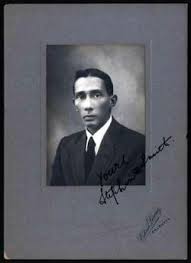
Smith launched almost 300 rockets between 1934 and 1945, working mostly unfunded and primarily alone. At 15:35 on April 10th 1935, Smith used a rocket to deliver a parcel containing 12 items, including a packet of tea, sugar, a spoon, a toothbrush and cigarettes, about a kilometre across a river. In the aftermath of a devastating earthquake, he illustrated the advantages of rocket-powered transport for quickly traversing difficult terrain. On 6th June 1935, he successfully launched a small consignment of first-aid material, consisting of rolls of bandages, lint, iodine, and aspirin, across the river Rupnarayan in West Bengal.
Smith’s 65th rocket launch, conducted on the morning of the 29th June 1935, was unique in its cargo and ambition. He demonstrated that living beings, and not just inanimate objects, could be transported by rockets. In a record-making flight, rocket power was used to transport a hen and a cock about 1km across a river. Smith had added stabilising fins, cut almond-shaped holes for ventilation and built shock-absorbing properties into the rocket design. The rocket did not employ a parachute, the soft sandy bank was critical and even to Smith’s surprise the hen and cock survived. Both flourished for at least 18 months in a private zoo in Calcutta (today known as Kolkata).
During the early 20th century, the story of rocket development is told through the cumulative contributions of iconic names such as Herman Oberth, Wernher von Braun, Sergei Korolev and Robert Goddard. Smith’s contribution cannot be compared to their work, but his work was not insignificant and has been mostly forgotten.
Smith was not a trained scientist or engineer. Eventually, he tested different types of rocket fuels, fins for attitude control and even designed a rocket to carry a camera to capture aerial images. Initially, he was not doing much more than lighting the blue touch-paper of a traditional firework and then standing back. But he was a man of vision and conducted numerous practical experiments to understand and promote the potential of rocket power as a means of transport.
Not much is known about his personal life. Smith was born in 1891 in Shillong, Assam. He was an Anglo-Indian, a group of people with a European (usually British) lineage, officially recognised in the Indian constitution. Not much is known about his parents. His father, Charles William Bath Taylor, was born in Brigg, Lincolnshire. His mother, Arabella Martin, was the daughter of an English tea planter and probably of mixed heritage. He attended St Patrick’s Boys School in Asansol, West Bengal, which was originally established by the Christian Brothers from Southern Ireland. It was a school for Anglo-Indian boys that he joined in 1903, the same year the Wright brothers successfully demonstrated flight in an aeroplane.
The first aeroplanes to fly in India did so relatively close to Asansol. On January 6th 1911, during Smith’s final year at school, more than 750,000 people gathered at the Calcutta racecourse to witness first-hand the magic of man-made flying machines. Smith must have known about the event; he was probably amongst the huge crowd. In the following month, on 18th February 1911, with a formal sanction from the Indian Postal Service, the world’s first official airmail consisting of about 6000 cards and letters was flown from Allahabad to the town of Naini, ten kilometres away. It is possible that this experience ignited an interest in aviation, airmail and eventually rockets that stayed with him for the rest of his life.
The First World War had accelerated the development of aviation in the same way that the Second World War did for rocketry. In the early 1920s, India saw the introduction of cargo airmail and scheduled passenger flights. Smith took an interest in tracking and recording developments in airmail just as steam engine locomotives had attracted enthusiasts in the past, and as spaceflight does today.
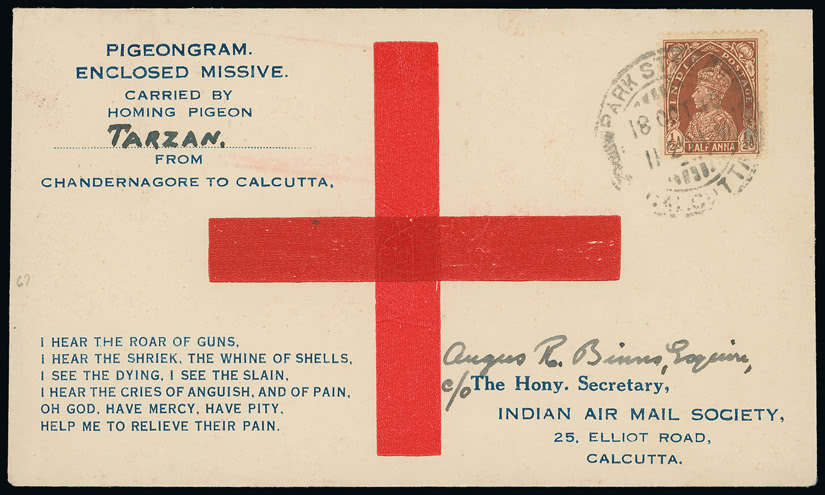
A global revolution in aerial transport was taking place just as Smith was starting his adult life. He had already been involved in Pigeon mail when the potential for airmail arrived. In the early 1930s, it was unclear what form of transport would triumph in the near future: airships, aeroplanes or rockets. The first airmail service from Britain to India was conducted by Imperial Airways. The flight left Croydon airport on 30th March 1929, arriving in Karachi on 6th April. On the return flight on the following day, Smith sent a letter to the King at Buckingham Palace in London. The King’s Private Secretary responded on 19th April on behalf of the Kin,g “to thank Mr Stephen H. Smith for the letter which he sent to his Majesty by the first flight from India to Great Britain”.
Philately was Smith’s primary preoccupation throughout his adult life. During the 1920s he founded the Calcutta Philatelic Club and the Aero Philatelic Club of India (which changed its name to the Indian Airmail Society on 19th January 1930). Almost all of his rocket launches contained signed souvenir covers and specially designed rocket mail stamps.
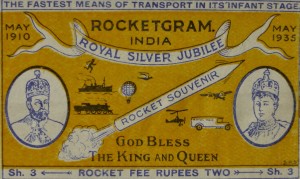
For his first trip to Sikkim in April 1935, he sought and was granted permission to print rocket gram stamps in four different colours. Two thousand of each colour were printed. His rocket launches received international press coverage. In July, Smith received a request in writing (via the King of Sikkim) from Mr A. W. Macintyre from New Jersey in the USA. He sought covers from each of Smith’s seven rocket flights. These flown covers were highly sought after by collectors then and are still today.
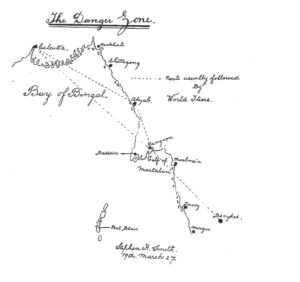
In addition to the regular newsletters for the Indian Airmail Society, Smith wrote “Indian Airways”, a work in three volumes detailing the first and special flights within and through India up to March 1930. In 1927, he authored a small book, “The World Flyer’s Danger Zone” covering the hazards of mail flights south east from Calcutta across the Bay of Bengal to Burma and Thailand. He dedicated the book and its proceeds to the widow of Arthur B Elliott, who was killed on July 4th 1926. Smith had met Elliott personally in 1925.
By the early 1930s, rocket mail experiments were being conducted in America, Europe and Australia. Smith was the only one launching rockets in India. He experimented with rocket launches from ship to shore, shore to ship, at night, across rough terrain and across rivers.
Smith recorded information about his flights, including sketches in his diary and took many pictures. The rockets were launched at a variety of angles, 30, 45, and even 80 degrees. He recorded wind speed and direction, and the distance the rocket covered, for every launch. He does not appear to have used any instruments to measure altitude, distance or speed so the measurements are likely to have been qualitative rather than quantitative. His largest rocket weighed about 7kg and was about 2m long. The payload was typically about half a kilogram but larger rockets were capable of carrying a kilogram.
In February 1936, Smith joined the British Interplanetary Society (BIS), founded in Liverpool three years earlier. He was probably the BIS’s first member from India. The BIS was one of many societies worldwide established to promote the development of rocket technology and its application to space travel. Through the BIS’s bulletin and journal, which reflected the contribution of its international membership, Smith would have been aware of the technological developments in rocketry worldwide, but there is no evidence of how much of what he learnt he put into practice in his own experiments.
After the start of the Second World War, Smith appears to have reduced the details he recorded and published on his rocket experiments. In 1940, he attempted two rocket launches carrying Brownie cameras to take aerial pictures. Neither succeeded. By December 1944, still based in Calcutta, Smith was experimenting with compressed air and compressed gas for rocket propulsion, rather than traditional solid fuel.

Despite his pioneering work with rockets, he probably did not accomplish his ambitions. He visited the kingdom of Sikkim twice in 1935 to conduct his rocket experiments. The second time, he took his wife and son with him. The king of Sikkim not only supported Smith’s work but also actively participated in his experiments by personally igniting some of the rockets. On April 11th 1935, following a successful firing of his rocket number fifty-four, a certificate was awarded to him in the presence of the king. This formal recognition was “certifying the utility of the rocket as a means of transport during floods and landslides”. Smith wanted to realise the potential of rocket power for transport for mail and materials, just as he was witnessing aeroplanes doing so in his time. His limited skills and resources prevented him from making significant advances. In 1992, a year after the centenary of his birth, the Indian government celebrated his achievements by issuing a stamp and a first-day cover dedicated to him and his work.
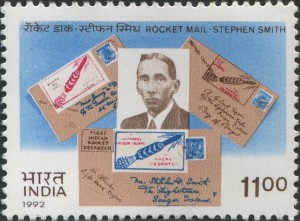
Not much is known of his personal life. After leaving school, Smith worked briefly at the customs department in Calcutta before joining the Calcutta police force as a Round Sergeant on 18th March 1913 on a salary of 100 rupees per month. Whilst with the police, he completed his dental training. His time with the Calcutta police was otherwise uneventful, and he resigned on the 4th December 1914. It was as a dentist that he served in the First World War after which he continued in this profession with a private dental practice based at his home address, on 25A Elliot Road in Calcutta.
He married Fay Harcourt in 1918, most probably another Anglo-Indian whom he had known at least since 1913. They had one son, Hector, who did not share his father’s interests. Smith died in 1951, and his wife died in 1985; both are buried in Kolkata. His son Hector married and had a son whose name is not known and a daughter, Gloria. The son grew up with a learning disability and was sent to an institution. Hector, with his wife, Gloria, and daughter, emigrated to Britain. Hector died shortly after arriving in Britain. Eventuall,y Gloria too got married and had a daughter called Lucy. As Smith’s only living descendant, Lucy may be living somewhere in Britain today.

The following clip is an interview with Mr Melvyn Brown. An Anglo-Indian who writes on Anglo-Indian topics, he lives on Elliot Road in Kolkata, a short walking distance from where Smith lived. He never met Stephen Smith, but near the end of this short interview, he recalls his meeting with Smith’s son, Hector.
Podcast: Play in new window | Download (Duration: 30:46 — 28.2MB) | Embed
Subscribe: Apple Podcasts | Spotify | RSS | More
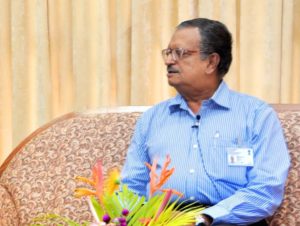 November 21st 2013, was the 50th anniversary of a rocket launched from India into space. The launch itself was an all-Indian affair, but with significant international support. The rocket was American, carried a French Sodium Vapour payload, and was assisted by a computer and a helicopter from the Soviet Union. From this meagre beginning, India has become a key player not only in building and launching rockets but also in designing, building, and deploying satellites.
November 21st 2013, was the 50th anniversary of a rocket launched from India into space. The launch itself was an all-Indian affair, but with significant international support. The rocket was American, carried a French Sodium Vapour payload, and was assisted by a computer and a helicopter from the Soviet Union. From this meagre beginning, India has become a key player not only in building and launching rockets but also in designing, building, and deploying satellites.
This episode was recorded on the site of that first launch. Then known as the Thumba Equatorial Rocket Launch Station and is today known as the Vikram Sarabhai Space Centre. Sundaram Ramakrishnan, the current director of the Vikram Sarabhai Space Centre (VSSC), talks about his 4-decade-long career with the Indian Space Research Organisation. He has played a central role throughout the development of India’s most reliable launcher – the Polar Satellite Launch Vehicle (PSLV).
Podcast: Play in new window | Download (Duration: 29:28 — 27.0MB) | Embed
Subscribe: Apple Podcasts | Spotify | RSS | More